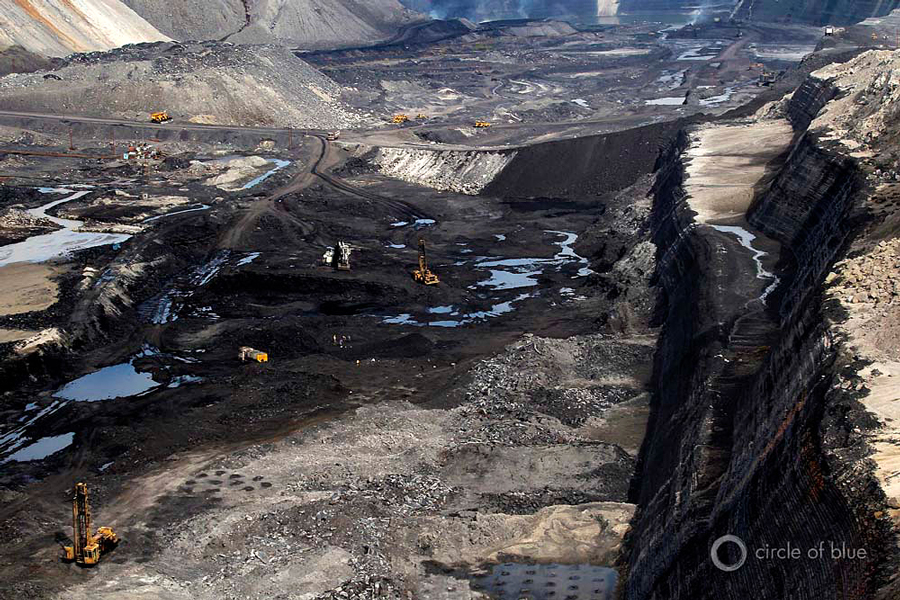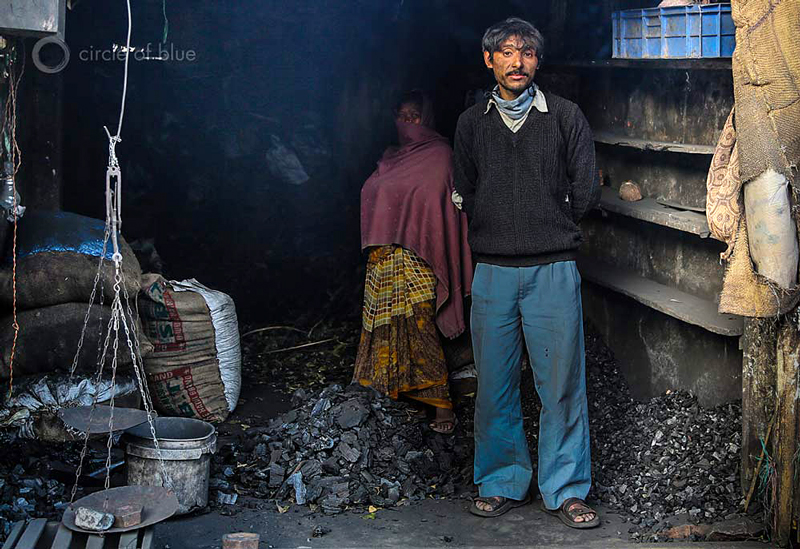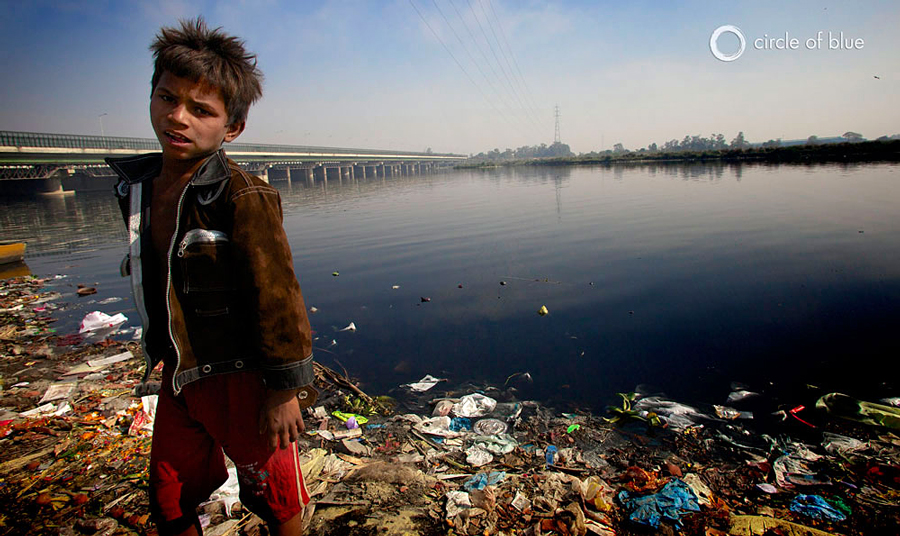-
India’s Faltering Energy Production, Damaged Water Resources Demand Modi’s Close Attention
July 24, 2014 By Keith SchneiderIndia’s new prime minister swept into office in May on a message of aspiration and a reputation for action.
During the nearly 13 years that Narendra Modi served as chief minister of Gujarat before becoming prime minister, his successes included drastically curtailing the number of hours that manufacturers in India’s premier industrial state went without electricity. The state’s transmission grid was strengthened and he promoted the development of 900 megawatts of solar generating capacity (equivalent to a large nuclear plant).

© Aubrey Parker/Circle of Blue India’s new prime minister swept into office in May on a message of aspiration and a reputation for action.
During the nearly 13 years that Narendra Modi served as chief minister of Gujarat before becoming prime minister, his successes included drastically curtailing the number of hours that manufacturers in India’s premier industrial state went without electricity. The state’s transmission grid was strengthened and he promoted the development of 900 megawatts of solar generating capacity (equivalent to a large nuclear plant).
A cycle of risk involving water, energy, and food that is harming India’s environment, slowing its economy, and impeding its development
These steps and many others fit Modi’s mantra of “less government and more governance,” as well as his deep understanding of the influence of adequate energy production in reviving a flagging economy.
Doing something similar at the national level is inordinately more difficult. In three long reporting trips to India since 2012, Circle of Blue and the Wilson Center have documented a cycle of risk involving water, energy, and food that is harming India’s environment, slowing its economy, and impeding its development.

© Dhruv Malhotra/Circle of Blue At the center of the cycle is India’s insistence on managing its natural resources as a social welfare program, which produces startling results:
- In Haryana and Punjab, India’s prime grain producing states, the policy of providing farmers free water, free electricity, and subsidized diesel fuel is producing endemic grain surpluses. Stout walls of burlap sacks filled with extra stock stand piled at government-financed depots. But the policy of free and subsidized water and energy, which affects 700 million people who live on farms, is also depleting the country’s aquifers and producing dire electricity shortages. Blackouts and brownouts are constant, hampered by the fact that even when supplies are theoretically sufficient, India’s old and inefficient power grid loses at least a quarter of the electricity that flows through it. Lack of power is not only hurting the nation’s capacity to establish more manufacturing businesses, but causing some foreign companies to move their operations and avoid India altogether.
- India has sought to diversify its power generating capacity by installing big hydroelectric dams and powerhouses high in the Himalayan range in five northern states. Hydropower plants receive substantial state and national government incentives and financing, not only to generate more electricity, but to serve as major centers of employment and Himalayan development. But the hydroelectric projects are expensive to build and difficult to operate in the world’s most hazardous mountains, prone to earthquakes, floods, and landslides. In recent years, as critics of hydro development have forecast for years, these challenges have impeded construction of new projects, slowing the growth generating capacity dramatically. In June 2013, a flood in Uttarakhand killed thousands of people, swept villages away, and seriously damaged dams and powerhouses. The ruinous flood also prompted a Supreme Court order and a special commission that called for Uttarakhand to halt development of 23 new dams. Both decisions raised fresh questions across India about continuing to aggressively pursue Himalayan power development.
-
The brightest outlook in India’s deeply troubled energy sector is wind and solar
Most of India’s electricity is fueled by coal. India pushes its coal mining sector – almost all of it state-owned – to produce as much as it can, leading to regular battles between citizens and utilities over water to cool power plants and rampant water pollution from mining. In the northeastern state of Meghalaya, coal mining is done by hand in dangerous pits and shafts. Deaths among miners are frequent and acid mine pollution is so intense that earlier this year a top court, the National Green Tribunal, ordered the state to shut the mines down until more effective safety and environmental regulations were put in place and enforced.
- The brightest outlook in India’s deeply troubled energy sector is clean energy, particularly the wind and solar industries. India is developing both industries in its dry desert states where climate conditions are the perfect fit. In 2003, according to the Central Electric Authority, renewable fuels and technology accounted for 1,628 megawatts of generating capacity, or 1.5 percent of India’s total generating capacity of 108,000 megawatts. On January 1 of this year, renewable generating capacity reached 30,178 megawatts, according to figures from the Ministry of New and Renewable Energy. That represents almost 13 percent of India’s total electrical generating capacity. Since 2003, renewable energy technologies have added an average of 2,600 megawatts of electrical generating capacity annually, according to the Central Electric Authority (22 percent of the total added capacity).

© J. Carl Ganter/Circle of Blue Good Times Ahead?
These trends and several more reported by Circle of Blue and the Wilson Center – including how coal production and combustion contribute to India’s heavily polluted air and water – confirm why energy production should be one of Narendra Modi’s top priorities.
The impressive growth in wind and solar is not sufficient to dramatically change India’s national energy outlook; electricity shortages are forecast to persist for decades.
Modi has a decent chance to fix some of this because he’s starting from a place of hope
Ten years after India regularly exceeded eight percent annual economic growth, and the nation was seen globally as the next industrial and high-tech juggernaut, India is slipping badly. It’s not just endemic corruption, impenetrable bureaucracy, deteriorating air and water, and rapid population growth that make doing business in India a test of courage, lack of electricity in almost every state makes doing business efficiently a test of patience.
These are the conditions that greet the new prime minister. Indians in every region, in every trade and profession, at every level of society understand that the social, economic, and ecological challenges that confront the nation need immediate attention and effective and active resolution. Modi has a decent chance to fix some of this because he’s starting from a place of hope that resonates with the country’s talented and determined people, what Modi called during the campaign, “Achche Din Aane Wale Hain,” the good times that are ahead.
But Modi needs to define what he means by “the good times.” In his first months in office he’s targeted a handful of priorities to work on immediately, priorities sorted from the extravagant number of problems that require solutions. At the very top is modernizing transportation infrastructure and more clean energy development. Both are steps toward improving energy efficiency and fixing India’s faltering energy production, changes that will also go a long way toward cleaning up the country’s air and water.

© J. Carl Ganter/Circle of Blue Closing a Widening Gap
There is, though, a very long way to go. The gulf between India’s energy production capacity and the capacity of the world’s industrial nations is immense and not closing.
The gulf between India’s energy production capacity and the capacity of the world’s industrial nations is immense
The United States consumes roughly 100 quadrillion BTUs (100 quads) of energy from coal, oil, natural gas, wind, hydropower, biomass, solar, and other sources, according to the Energy Information Administration, a U.S. data agency. China’s total energy consumption is 115 quads. India this year will consume roughly 25 quads of energy from all sources, its energy consumption growing about 1 quad annually. At that pace it would take the rest of the century to reach energy consumption levels comparable to those in the United States and China today.
India is rich in energy resources, talented in engineering and design, and immensely ambitious. But its management of the energy sector and its undisciplined understanding of the limits of technology and ecology in an era of climate disruption are important factors hampering energy production.
The Central Electric Authority and the Ministry of Power reported in 2013 and again this year that shortages of coal caused power plants across India to operate well below their generating capacities. In some cases new plants did not open because of lack of fuel.
The figures provide clear evidence that India is not likely to match energy production and consumption levels consistent with those in the Western democracies or in China. Modi’s most important task over the next several years is raising electrical generating capacity and helping his nation reach a new definition of “the good times.”
Keith Schneider, who developed the Global Choke Point project, is senior editor and chief correspondent at Circle of Blue. A two-time winner of the George Polk Award and other honors for his work, he also reports on energy, agriculture, the environment, and policy for The New York Times, where he has served as a national correspondent and contributor since 1981.
Sources: Central Electric Authority (India), Ministry of Power (India), U.S. Energy Information Administration.
Photo Credits: All photos used with permission courtesy of Circle of Blue.
Topics: agriculture, China, Choke Point, climate change, coal, development, economics, energy, environment, featured, food security, India, natural resources, poverty, South Asia, U.S., water
 A Publication of the Stimson Center.
A Publication of the Stimson Center.







